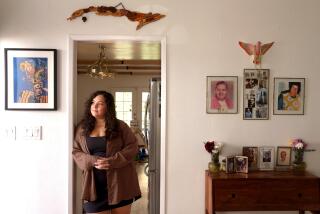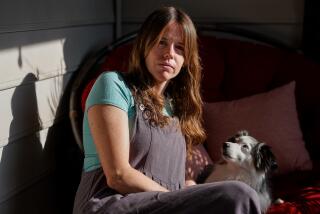Keeping Art Alive : In an Era of Educational Cutbacks, Temple City Teacher Inspires Creativity in Everything From Clay to Film
Technically, Corky Dunn is an art teacher. But she thinks of herself as a âmind farmer.â
In her beginning art classes at Temple City High School, Dunn instructs her students in the use of 27 different media. Learning to weld bronze or model papier-mache, Dunn believes, is a way to learn to think. âIf we need tools, we make them,â she said of her students. âI want them to know they can do things with their own hands.â
Earlier this year Dunn, 46, was one of 10 finalists for the Music Centerâs sixth annual Bravo awards. According to a spokesman for the Music Centerâs education department, the awards recognize outstanding achievement in keeping the arts alive in local schools.
Dunn and the other educators were chosen from among 134 nominees from five counties. The winners were Herb Holland, who teaches drama and English at Audubon Junior High School in Los Angeles, and Shanon Fitzpatrick, who teaches fourth grade at Morse Elementary School in Placentia.
At a time when the arts are beleaguered in the schools, Dunn is a passionate defender of their place in the curriculum. She is horrified that some people think of art or the performing arts, which she also teaches, as an adjunct to education, an extra that can be dropped when money is tight.
âArt is a basic,â said Dunn, who has taught at Temple City High for 23 years. âWeâre not on the fringe. Weâre in the center of everything.â
Dunnâs view is evidently shared by the Temple City Unified School District. âThe Board of Education and the administration have always been supportive,â Dunn said. Students at Temple City High School can still study individual musical instruments, join the choir or sign up for a dance class, courses no longer offered in many public schools.
According to Miguel Muto, consultant for the visual and performing arts in the California Department of Education, art was in decline in the schools for almost a decade until 1985-86, when about 630,000 high school students were enrolled in visual arts programs, a modest gain of 9,000 over the previous year.
Figures for 1986-87 are not available, Muto said, but arts enrollment may have been bolstered by the stateâs requirement, in effect since 1986, that high school graduates must take a course in either the visual or performing arts or a foreign language.
Muto also noted that in 1976 the state had 400 art and music administrators at the school district level. That number has shrunk to fewer than 60.
One of Corky Dunnâs most remarkable abilities, colleagues say, is a gift for reaching students who have not flourished in the schools. Dan Mooney, Temple Cityâs assistant principal, noted that Dunn often elicits startlingly good work from students who have been chronic truants or troublemakers.
âShe has this Pied Piper ability to attract those kids who are marching to the tune of a different drum,â Mooney said, âand once she gets hold of them, sheâs inspirational.â
In Mooneyâs view, a key to Dunnâs success as an educator is her high expectation for all students, whatever their test scores.
Film, which students can take for three years, is one of Dunnâs most popular courses. Now a mentor teacher in video technology for the school district, Dunn knew little about video or film making until a student came to her eight years ago and said: âI want to be in your art class, but I want to make films.â
âI said: âIâve never made a film, but weâll try,â â Dunn recalled.
âWe started out with one Super-8 camera and one light bulb,â she said. Since then, she and her students have built a Spartan but functional production studio, complete with professional editing equipment. Students spend hour after hour there as they put together such projects as the schoolâs annual video yearbook. Recent student creations include a documentary on soaring called âDreamsâ and a fictional short entitled âBoy Scout Zombie From Hell.â
Studentsâ work is strictly their own. âIâm a facilitator,â Dunn said. âI set the scene, but they have to be the play.â
Early on, Dunnâs young artists wanted a more professional identity for themselves. They formed a student film and video production company called DragonFlicks Ltd. that has persisted on campus. Like many of her students, Dunn is an admirer of dragons, which she described as âgrand and noble things.â
Students must get satisfactory grades to join DragonFlicks, which is the name they put on their films. The group also provides technical services throughout the district, including doing the lighting, sound and filming for various school performances. Members, who are paid for some jobs, have DragonFlicks business cards and green-and-gold jackets, just as campus athletes do.
On a recent afternoon the production studio was filled with student animators. The youngsters were practicing âclaymationâ--the technique that gave the world Gumby and the singing California raisins. The students also learn how to paint cels, the individual paintings on transparent plastic that are filmed in sequence to make traditional cartoons seem to move.
Under the bright studio lights, seniors Kevin Smith and Cathy Mason said that they were filming a battle involving imaginary creatures called âblivitsâ they had made from clay. They had been manipulating their blivits, moving them a bit, then filming them frame by frame, for two weeks. The result was five minutes of cartoon carnage.
Nearby other students were filming the demise of a unicorn. They stuffed more and more of the one-horned creature into the maw of a menacing clay blob, which would appear to be eating it in the finished film.
âPeople assume art is so nebulous you canât grade it or do it on a schedule,â Dunn said. Not so. She gives written exams as well as practical ones and expects students to meet deadlines. She does not, however, grade students against one another.
Instead, students are graded according to how successfully they complete the task they set out to do, be it a wax sculpture or an oil painting. As a result, Dunn said, blind students have done well in her art courses.
âArt is like math or anything else,â Dunn said. âIt can be taught.â She teaches it step by step, skill by skill. But creativity doesnât have to be taught, she said. Itâs already there, waiting to be unleashed. âIf I can just stop them from saying, âI canât do it,â then Iâve got them. If I can remove the fear, I can teach them.â
After mastering specific skills, Dunnâs students discover that they can make objects out of visions--the magic that artists work.
Her courses, senior Greg Clark said, âallow you to be creative beyond the normal boundaries of school.â Without such courses, he added, âthe people who have large imaginations have nothing to put them to.â
Dunn is proud that many of her students go on to study the arts in college and find creative jobs. Indeed, the way she talks about it, teaching is a creative art, a way of helping students transform themselves.
âWe are a little idealistic,â Dunn said of teachers. âWeâre more interested in what might be than what is.â
More to Read
The biggest entertainment stories
Get our big stories about Hollywood, film, television, music, arts, culture and more right in your inbox as soon as they publish.
You may occasionally receive promotional content from the Los Angeles Times.










